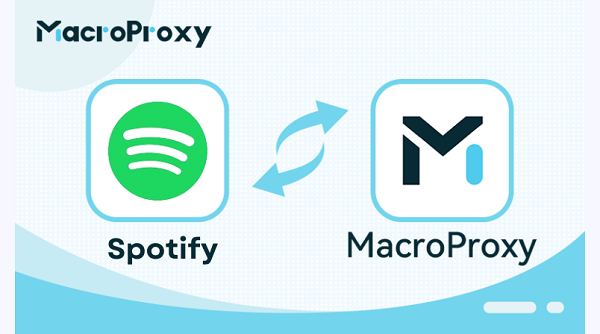Why Proxies Are Essential for Ad Verification&How to Choose
Protect your brand from ad fraud with ad verification proxies. Learn how proxies help verify ads across locations, devices, and platforms.
Post Time:2025-03-28
Discover how a Spotify proxy can enhance music streaming experience. What a proxy service is, why you need one, how it works, and how to choose and configure your Spotify proxy settings.
Spotify, a leading music streaming platform, offers a vast library of songs, podcasts, and playlists to its global user base. However, due to licensing restrictions and geographical limitations, some content may not be accessible to all users. This is how a Spotify proxy works. This article covers what a proxy service Spotify is, why you use it, how it works, how to choose and configure Spotify proxy settings.

A Spotify proxy is a server that acts as an intermediary between the user and Spotify's servers. It allows users to mask their original IP address and replace it with one from a different location. This is particularly useful when trying to access Spotify content that is geographically restricted or blocked in a user's region.
Aside from the reasons for using Spotify proxies to bypass country restrictions and access otherwise restricted popular music streaming. With the help of special web scraping tools or scripts, people could also use proxies to collect data from the service.
But if you start using web scraping bots on Spotify without a proper proxy, your online activity will be flagged or even banned. Therefore, you need to use a good set of static or rotating proxies from reliable pools carefully and extensively.
Companies use Spotify for a variety of business and marketing goals, which data from the following areas can impact:
It would be nearly impossible to collect the required amounts of this type of data elsewhere. So people use Spotify proxy settings from another country to obtain information to fine-tune its advertising campaigns based on the music preferences of millions of people. They do this by running custom agent-powered bots in stealth mode to give them an edge over the competition.
It's clear that Spotify also knows how to use this data and is trying to prevent all kinds of unauthorized scraping. So if you try to use some randomly picked "free" proxy for data collection, you probably get banned most of the time. You may need to purchase a residential proxy with unlimited bandwidth from a trustworthy provider that meets all requirements to get successful scraping tasks.
When you use a Spotify proxy, your request to access Spotify's content is sent to the proxy server first. The proxy server then forwards your request to Spotify, using an IP address from a location where the content is accessible. Spotify's servers, seeing the request as coming from a permissible location, grant access to the content. The proxy server then retrieves the content and sends it back to you. This whole process is seamless and invisible to users.
Since Spotify is based in the United States, we recommend using a US proxy for optimal performance. The best proxy for Spotify will depend on your specific needs, such as the level of anonymity you require and your streaming habits.
For a comprehensive solution, US Residential Proxies that support SOCKS5 are highly recommended. This combination increases your chances of connecting without issues and minimizes the risk of unnecessary system interruptions.
Additionally, it’s crucial to choose a high-quality proxy server. Look for providers that offer fast, reliable services free from regional restrictions and other potential blockages. By selecting the right proxy, you can enhance your Spotify experience and enjoy seamless streaming.
Here's a general step-by-step guide:
Step 1: Choose a Proxy Service
First, you'll need to choose a proxy service. There are a lot of available ones, some popular ones include Oxylabs, MacroProxy, and SmartProxy. Make sure to choose a service that offers servers in the location where you want to access Spotify content.
Step 2: Obtain Proxy Information
Once you've chosen a proxy service, you'll need to obtain the necessary information to set up the proxy. This usually includes the proxy server's address, port number, and type (HTTP, HTTPS, SOCKS4, or SOCKS5). If the proxy needs authentication, you'll also need a username and password.
Step 3: Open Spotify
Open the Spotify application on your device. Click on the downward arrow next to your profile name in the top-right corner and then click on "Settings".
Step 4: Scroll Down to Proxy Settings
For the settings menu, just scroll down until you find the "Show Advanced Settings" button. Click on it and then scroll down to the "Proxy" section then.
Step 5: Enter Proxy Information
In the "Proxy Type" dropdown menu, select the type of proxy you're using. Then, enter the proxy server's address and the port number in the "Proxy Port" field. If you need proxy authentication, enter your username and password in the respective fields.
Step 6: Save Settings
Go to the "OK" button to save all the settings. Spotify will now use the proxy server to connect to the internet.
Notes:
Remember, while a Spotify proxy can help you access more content, it's important to use it responsibly and respect Spotify's terms of service.
The exact steps and names of settings may vary depending on the device and the version of Spotify you're using. If you're having trouble, check the help section of your proxy service or Spotify's support resources.
Spotify proxy is a valuable tool for music lovers and podcast enthusiasts who want to enjoy unrestricted access to Spotify's vast library. By masking your IP address and bypassing geographical restrictions, a Spotify proxy allows you to explore and enjoy content from all over the world. And it's important to choose a reliable and secure proxy service to protect your privacy and ensure a smooth streaming experience. Always remember to use such tools responsibly and follow the terms of service.
< Previous
Next >